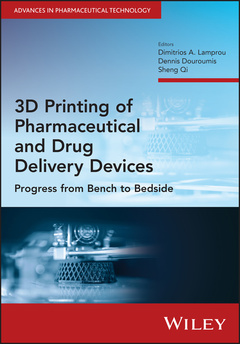3D Printing of Pharmaceutical and Drug Delivery Devices Progress from Bench to Bedside Advances in Pharmaceutical Technology Series
Coordonnateurs : Lamprou Dimitrios A., Douroumis Dennis, Qi Sheng

Discover the latest, fast-developing technology to help move towards more cost-effective, small-batch, decentralized manufacturing of personalized systems
3D printing has revolutionized manufacturing. Its precision and flexibility have enabled the large-scale production of materials and devices too complex for conventional industrial manufacturing. This has been particularly revolutionary in the field of pharmaceutical production, where 3D printing is being integrated into the manufacture of both drugs and drug delivery devices. It has never been more important for industry professionals to understand this form of production.
3D Printing of Pharmaceuticals and Drug Delivery Devices: Progress from Bench to Bedside offers a comprehensive overview of 3D printing technology and its pharmaceutical applications. It introduces readers to a world in which bespoke drug delivery systems developed for specific users or conditions is rapidly becoming a reality. Its detailed coverage of strategies and industrial processes incorporates the latest research and real-world experience of production.
3D Printing of Pharmaceuticals and Drug Delivery Devices: Progress from Bench to Bedside readers will also find:
- A multi-disciplinary authorial team of industry leaders
- Discussion of common technical and regulatory barriers and their possible solutions
- Far-ranging discussion of pharmaceutical applications across all sectors
3D Printing of Pharmaceuticals and Drug Delivery Devices: Progress from Bench to Bedside is essential reading for pharmaceutical industry professionals and researchers looking to occupy the leading edge.
About the Editors xv
List of Contributors xvii
Series Preface xxi
Preface xxiii
1 Materials for 3D Printing 1
Thomas McDonagh, Bin Zhang and Sheng Qi
1.1 Introduction 1
1.2 Material Processability Considerations for Pharmaceutical 3DP 2
1.3 Classification of Common Materials Used in Pharmaceutical 3DP 14
1.4 Conclusions and Future Perspectives 19
2 The Use of Microstructure Design and 3D Printing for Tailored Drug Release 29
Bin Zhang, Thomas McDonagh, Joey Yan, Andy Glendale, Richard Bib, Peter Belton and Sheng Qi
2.1 Introduction 29
2.2 3D-Printing Technologies 30
2.3 3D Design for Drug-Loaded Device 33
2.4 3D Designs Influence Drug Release 36
2.5 Challenges and Perspective 39
3 3D Printing of Oral Solid Dosage Forms Using Selective Laser Sintering 43
Atabak, Tabriz Ghanizadeh, Hannah Kuofie, James Scoble, Sam Boulton and Dennis Douroumis
3.1 Introduction 43
3.2 Operational Principles of Selective Laser Sintering 46
3.3 3D-Printed Oral Dosages 50
3.4 Advantages of SLS 59
3.5 Conclusions 61
4 3D Printing for Medical Device Applications 65
Jian-Feng Zhang, Bernabe Tucker, John Tipton, Mahrokh Dadsetan, Scott Jones, Andrea Engel, Theresia Kuntz and Cecile Boudot
4.1 Introduction 65
4.2 3D Printers 66
4.3 Biomaterials for 3D-Printed Medical Devices 69
4.4 3D-Printed Personalised Medical Devices 76
4.5 Regulatory 81
4.6 Future Perspectives 83
5 3D Printed Implants for Long-Acting Drug Delivery 89
Aikaterini Dedeloudi, Sune Andersen, Peyton Hopson and Dimitrios A. Lamprou
5.1 Introduction 89
5.2 Types of 3D-Printed Scaffolds 90
5.3 Critical Parameters in Designing 3D-Printed Implantable Scaffolds 94
5.4 Critical Parameters in Selecting Materials for 3D-Printed Scaffolds 97
5.5 Manufacturing Techniques for Implantable Scaffolds 100
5.6 Drug Release Mechanism of Long-Acting 3D-Printing Polymeric Implantable Systems 105
5.7 Outlining Regulatory Framework for 3D-Printed Implantable Scaffolds 106
5.8 Conclusions 108
6 Wound Dressings by 3D Printing 115
Joshua Boateng
6.1 Wound Healing Process 115
6.2 Case Studies 122
6.3 Summary/Conclusions 126
7 3D Printing of Hydrogels 131
Poornima Ramburrun and Yahya E. Choonara
7.1 Introduction 131
7.2 Applications of 3D-Printed Hydrogels 132
7.3 Types of Hydrogel Materials for 3D Printing 133
7.4 3D Printing Techniques for Hydrogels 136
7.5 Printability and Printing Parameters 138
7.6 Clinical Translation 145
7.7 Conclusions 146
8 Analytical Characterisation of 3D-Printed Medicines 151
Ana Luiza Lima, Lívia L. Sá-Barreto and Marcilio Cunha-Filho
8.1 Introduction 151
8.2 Preformulation 153
8.3 In-Process Characterisations 159
8.4 Final Product 166
8.5 Conclusions 171
9 Adoption of 3D Printing in Pharmaceutical Industry 179
Thomas Kipping
9.1 Partnering and Growing 181
9.2 Regulatory Strategy 182
9.3 Business Model 184
9.4 Regulatory Strategy 185
9.5 Partnering and Growing 185
9.6 Business Model and Strategy 185
10 Clinical Benefits of 3D Printing in Healthcare 187
Atheer Awad, Iria Seoane-Viaño, Abdul W. Basit and Alvaro Goyanes
10.1 Introduction 187
10.2 3D Printing Technologies 189
10.3 Preclinical Applications of 3D Printing 190
10.4 Clinical Applications of 3D Printing 195
10.5 Challenges, Regulatory View and Future Applications 202
10.6 Conclusion 203
11 Regulatory Aspects of 3D-Printed Medicinal Products 211
Maria Malamatari, Ka-Wai Wan and Fotios Baxevanis
11.1 Introduction 211
11.2 Current Regulatory Framework 212
11.3 Quality Aspects of 3D-Printed Medicinal Products 213
11.4 3D-Printed Paediatric Medicinal Products 218
11.5 3D-Printed Systems With Tailored Release Profiles 220
11.6 Conclusions 221
Disclaimer 221
References 222
Index 227
Edited by
Dimitrios A. Lamprou, (PhD MBA) is the Chair of Biofabrication and Advanced Manufacturing & Director at MSc Industrial Pharmaceutics at Queen’s University Belfast. He is a subject matter expert in Emerging Biopharmaceutical & Pharmaceutical Technologies. Has been named in the Stanford University’s list of World’s Top 2% Scientists, for several consecutive years.
Dennis Douroumis, PhD is Professor in Pharmaceutical Technology and Process Engineering at the University of Greenwich, UK. He has published very widely on pharmaceutical technology and has received awards and honors including an Eminent Fellowship of the Academy of Pharmaceutical Sciences.
Sheng Qi, PhD is Professor in Pharmaceutics at the School of Pharmacy, University of East Anglia. She has published very widely on pharmaceutical 3D printing and industrial pharmaceutics, and has a strong record of both clinical and industrial partnerships.
Date de parution : 06-2024
Ouvrage de 400 p.
17x24.4 cm
